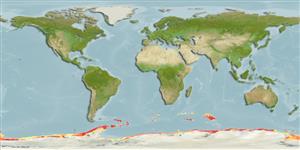Environment: milieu / climate zone / depth range / distribution range
Écologie
marin démersal; océanodrome (Ref. 51243); profondeur 1 - 1010 m (Ref. 114491). Polar; 45°S - 78°S, 180°W - 180°E
Circumpolar south of Antarctic Polar Front, but not found in Ross Sea; adults only in higher latitudes (South Orkneys, South Shetlands, Peter Island) and south of the Weddell-Scotia confluence, but adults and juveniles in the region of South Sandwich I, South Georgia and Bouvet. Reported from off the Cape, South Africa and from 43°17'S, 48°55'E (Ref. 4066).
Length at first maturity / Taille / Poids / Âge
Maturity: Lm 7.4 range ? - ? cm
Max length : 11.5 cm SL mâle / non sexé; (Ref. 114491); 10.3 cm SL (female); poids max. publié: 15.00 g (Ref. 124149); âge max. reporté: 4 années (Ref. 94119)
Épines dorsales (Total) : 0; Rayons mous dorsaux (Total) : 14 - 16; Épines anales: 0; Rayons mous anaux: 19 - 22.
Oceanic and mesopelagic, found in the upper 100 m south of the Antarctic Polar Front but deeper northwards (Ref. 4066). Adults take more euphausiids and also prey upon polychaetes. The diet of juveniles of less than 6 cm SL consists mainly of copepods, with some euphausiids and hyperiids. Possibly the most common myctophid occurring south of the Antarctic Polar Front.
Life cycle and mating behavior
Maturité | Reproduction | Frai | Œufs | Fécondité | Larves
Hulley, P.A., 1990. Myctophidae. p. 146-178. In O. Gon and P.C. Heemstra (eds.) Fishes of the Southern Ocean. J.L.B. Smith Institute of Ichthyology, Grahamstown, South Africa. (Ref. 5182)
Statut dans la liste rouge de l'IUCN (Ref. 130435: Version 2024-1)
Menace pour l'homme
Harmless
Utilisations par l'homme
Outils
Articles particuliers
Télécharger en XML
Sources Internet
Estimates based on models
Preferred temperature (Ref.
123201): -0.2 - 1.2, mean 0.4 °C (based on 610 cells).
Phylogenetic diversity index (Ref.
82804): PD
50 = 0.5312 [Uniqueness, from 0.5 = low to 2.0 = high].
Bayesian length-weight: a=0.00832 (0.00463 - 0.01496), b=3.08 (2.92 - 3.24), in cm total length, based on LWR estimates for this species & (Sub)family-body (Ref.
93245).
Niveau trophique (Ref.
69278): 3.2 ±0.4 se; based on diet studies.
Generation time: 6.5 ( na - na) years. Estimated as median ln(3)/K based on 2
growth studies.
Résilience (Ref.
120179): Milieu, temps minimum de doublement de population : 1,4 à 4,4 années (K=0.17-0.25; tmax=11).
Fishing Vulnerability (Ref.
59153): Moderate vulnerability (41 of 100).
Nutrients (Ref.
124155): Calcium = 63.5 [23.8, 202.8] mg/100g; Iron = 0.649 [0.225, 1.681] mg/100g; Protein = 15.4 [13.5, 17.5] %; Omega3 = 0.92 [0.39, 2.31] g/100g; Selenium = 13.9 [4.6, 38.8] μg/100g; VitaminA = 49.6 [8.9, 301.0] μg/100g; Zinc = 0.657 [0.347, 1.130] mg/100g (wet weight); based on
nutrient studies.
